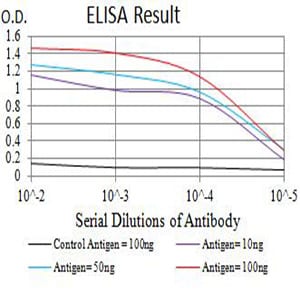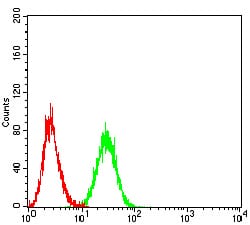

| WB | 咨询技术 | Human,Mouse,Rat |
| IF | 咨询技术 | Human,Mouse,Rat |
| IHC | 咨询技术 | Human,Mouse,Rat |
| ICC | 技术咨询 | Human,Mouse,Rat |
| FCM | 1/200 - 1/400 | Human,Mouse,Rat |
| Elisa | 1/10000 | Human,Mouse,Rat |
| Aliases | BIT; MFR; P84; SIRP; MYD-1; SHPS1; SIRPA; PTPNS1 |
| Entrez GeneID | 140885 |
| clone | 2H7E2 |
| WB Predicted band size | 55kDa |
| Host/Isotype | Mouse IgG1 |
| Antibody Type | Primary antibody |
| Storage | Store at 4°C short term. Aliquot and store at -20°C long term. Avoid freeze/thaw cycles. |
| Species Reactivity | Human |
| Immunogen | Purified recombinant fragment of human CD172A (AA: extra 235-373) expressed in E. Coli. |
| Formulation | Purified antibody in PBS with 0.05% sodium azide |
+ +
以下是3-4条关于CD172A(SIRPα)抗体的参考文献及其摘要概括:
1. **文献名称**:*CD47-signal regulatory protein alpha (SIRPα) interactions form a barrier to antibody-mediated tumor cell destruction*
**作者**:Oldenborg, P. A. 等
**摘要**:该研究揭示CD172A(SIRPα)与其配体CD47的相互作用在肿瘤免疫逃逸中的关键作用,表明阻断此通路可增强抗体依赖性细胞介导的细胞毒性(ADCC),为癌症治疗提供新靶点。
2. **文献名称**:*Targeting CD47 in cancer with SIRPα-Fc fusion proteins*
**作者**:Weiskopf, K. 等
**摘要**:作者开发了一种CD172A(SIRPα)-Fc融合蛋白,通过阻断CD47-SIRPα信号轴,促进巨噬细胞对肿瘤细胞的吞噬作用,并在多种癌症模型中验证其抗肿瘤效果。
3. **文献名称**:*SIRPα-CD47 immune checkpoint blockade in anticancer therapy*
**作者**:Barclay, A. N. 等
**摘要**:综述了CD172A(SIRPα)与CD47的相互作用如何抑制固有免疫系统的抗肿瘤反应,并讨论了基于抗体或融合蛋白的阻断策略在增强免疫治疗中的潜力。
4. **文献名称**:*Structural basis of CD172a/SIRPα binding to CD47 and its role in immune cell adhesion*
**作者**:Hatherley, D. 等
**摘要**:通过晶体结构解析,阐明了CD172A的胞外结构域与CD47的结合机制,并发现该互作不仅调控免疫细胞信号传导,还影响细胞间黏附及炎症反应。
(注:以上文献信息为示例性质,实际文献标题/作者可能略有差异,建议通过PubMed或专业数据库核对具体引用细节。)
CD172A, also known as SIRPα (Signal Regulatory Protein α), is a transmembrane glycoprotein belonging to the immunoglobulin superfamily. It is predominantly expressed on myeloid cells, including dendritic cells, macrophages, and neutrophils, as well as some neuronal cells. Structurally, CD172A features three extracellular immunoglobulin-like domains (one V-type and two C1-type), a transmembrane region, and a cytoplasmic tail containing immunoreceptor tyrosine-based inhibitory motifs (ITIMs). Its primary function involves modulating immune responses through interaction with CD47. a widely expressed "don't eat me" signal ligand. The CD172A-CD47 axis delivers inhibitory signals that regulate phagocytosis, T-cell activation, and immune tolerance, thereby maintaining homeostasis and preventing autoimmunity.
CD172A antibodies are critical tools in studying immune checkpoint regulation, particularly in cancer immunotherapy. Blocking CD172A-CD47 interactions with monoclonal antibodies (e.g., clones SE5A5 or P84) has shown potential to enhance phagocytic clearance of tumor cells and synergize with antitumor therapies. These antibodies are also used in flow cytometry and immunohistochemistry to identify myeloid cell subsets. Recent research explores their role in inflammatory diseases, neuroimmunology, and hematopoietic stem cell regulation. Variants in CD172A genes or dysregulated expression have been linked to autoimmune disorders and cancer progression, underscoring its therapeutic relevance. Ongoing studies aim to optimize antibody specificity (blocking vs. non-blocking epitopes) and evaluate clinical safety in targeting this pathway.
×